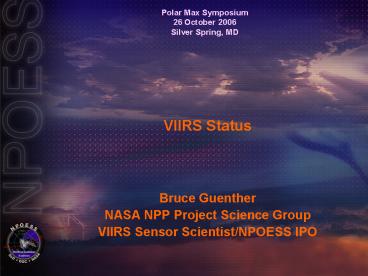VIIRS Status - PowerPoint PPT Presentation
1 / 17
Title:
VIIRS Status
Description:
EFR essentially an anomaly report ... suggest potential for optical effects within Dewar, still under investigation ... Formal determination for 'use-as-is' or ... – PowerPoint PPT presentation
Number of Views:101
Avg rating:3.0/5.0
Title: VIIRS Status
1
VIIRS Status
- Bruce Guenther
- NASA NPP Project Science Group
- VIIRS Sensor Scientist/NPOESS IPO
2
VIIRS Development Effort Teammates Staffing
- Engineering Efforts supported by several
organizations - Raytheon-SBRS effort Ed Clement, Eric Johnson
and colleagues - NGST Eric Kinder, Jim McCarthy and colleagues
- IPO Gary Ross, Bob Murphy and colleagues
- NASA-GSFC Tim Trenkle, GSFC engineering
- Aerospace Frank DeLuccia, JR Swenson and
colleagues - MIT-Lincoln Labs, Navy Research Laboratory and
Raytheon El Segundo
3
Background Reminders
- NPOESS Preparatory Project (NPP) is risk
reduction activity for NPOESS - NPP is joint NPOESS-IPO and NASA mission
- NPP can not be used in formal NPOESS System-level
requirements sell-off - NASA NPP mission objectives are data continuity
and Climate Data Records - VIIRS Engineering Development Unit (EDU) is risk
reduction for NPOESS and NPP - Sensor Data Records performance requirements
defined as worst-case, end of life and end of scan
4
EDU Status
- Sensor completely built
- Thermal Vacuum (TV) testing complete
- Some post TV root- and contributory-cause testing
continues - EDU design primarily flight-like
- Differences in cooled focal plane read-out
designs and Dewar configuration - Slower focal length (but also has been tested in
ambient with flight like focal length) - EDU testing for proof of concepts
5
On-board Calibrators
- Solar Diffuser (SD) and SD Stability Monitor
(SDSM) for Reflective Solar Bands (RSB) - SD screen to reject Earthshine in fabrication
- SDSM not installed in EDU
- No end to end testing of SD-path in EDU program,
under study with NIST for FU1 and beyond - Black-body and Space View primarily for Thermal
Emissive Bands (TEB)
6
EDU Test Date Summary
- Performance generally as expected, but with some
differences - Differences described as the Big 3 EFRs
- EFR essentially an anomaly report
- LSF/IFOV, BBR and Cross-talk Line Spread
Function/Instantaneous Field of View,
Band-to-Band Registration - Concerns present in both ambient and TV test
results - Root-cause and path-forward plans are component
of FU1 integration and testing agreements
7
IFOV/LSF
- Effects mapped for single pixel resolution,
reported in context of 1 pixel requirements - Ambient IFOV
- DNB pixels (some, not all) small
- I Bands
- I1, I2 large (scan)
- I3, I4, I5 large (track)
- I5 small (scan)
- Thermal Vacuum IFOV
- I1 I4 large temperature sensitivity (scan)
- M-Band effects relatively smaller due to lower
spatial resolution
8
Moderate HSR observed FP avg. registration
shifts in TV for the VIIRS EDU, Mod. HSR units
track
LWIR SWIR VisNIR
scan
PreTV
10 C
-13 C
-36 C
25 C
BTC cooled
PostTV
Cryoradiator cooled
Aspect ratio not to scale
9
Imaging registration shifts in TV for the VIIRS
EDU, Imaging HSR units
track
I5 I3/I4 I2
scan
PreTV
10 C
-13 C
-36 C
25 C
BTC cooled
PostTV
Cryoradiator cooled
Aspect ratio not to scale
10
Band to Band Registration (BBR)
- EDU had larger-than-expected BBR shifts
- Shift between ambient and thermal vacuum
(warm-to-cold) - VisNIR vs LWIR scan direction of 0.25 M band HSR
- FU1 performance prediction better than this due
to Dewar redesign - Shift over temperature
- VisNIR vs LWIR scan direction of 0.25 M band HSR
- VisNIR vs LWIR track direction of 0.15 M band HSR
- FU1 performance prediction better than this due
to Dewar redesign - Pre-TVAC to post TVAC offset
- May be hysteresis up to 7 M band HSR
- Alternatively may be uncertainty in alignment
response to bench test cooler, use-to-use
11
Cross-talk
- Distinguishing optical from electronic effects
still underway - Analyses suggest potential for optical effects
within Dewar, still under investigation - Common description of various test results still
being developed - Magnitude of effects TBD
- Potential remains for significant impact to
radiometric stability/accuracy
12
Predicted Temperature Environments
Laboratory Ambient
NPP Orbit
NPOESS Orbit
13
Potential NPP Mitigation Opportunities
- LSF/IFOV/BBR effects above for individual pixels
- 3-pixel aggregation within 31.59º of NADIR
2-pixel aggregation extends to 44.82º of NADIR - Significantly smaller temperature ranges for NPP
only orbit - Significant mitigation of IFOV/BBR effects
obtained in 3-pixel and 2-pixel aggregation
regions
14
Data Distribution and Analyses Approaches
- All test data sets delivered to CasaNOSA
- Primary delivery mechanism is via circulation of
hard drives - Some data over Internet connection
- Data users identify highest priority files
- Sensor builder (SB) holds daily table-top
discussions including in-plant customer community - Customer community holds daily teleconferences
- Monthly SB driven Data Review and release
meetings - Government Team and shoulder-to-shoulder omnibus
data reviews at completion of testing.
15
Data Analysis Teams
SBRS
Todd Hurt, leader
Early Analysis Test Reports Anomaly
Reporting Formal Test Reports - Leads to FU1
Compliance Determinations
NGST
NASA
H. Oudrari, coordinator
Jim McCarthy, leader
Systems Engineering
Primary science interface to SBRS and
NGST Cal/Val efforts by Lushalan Liao
NICST - Xiong Oceans Turpie U. Wisc.
LaPorte Land Team - Wolfe
IPO
F. DeLuccia, leader
Aerospace team MIT/LL Fischer NRL, DC - Lucke
gt 100 Data Reports written on EDU tests
16
Concluding Remarks
- Risk reduction with EDU testing a success
- Some significant work remains
- Cross-talk and fixture verification
- Formal determination for use-as-is or changes
for FU1 NET 12/06 - FU1 will be delivered from SBRS
17
National Polar-orbiting Operational Environmental
Satellite System

